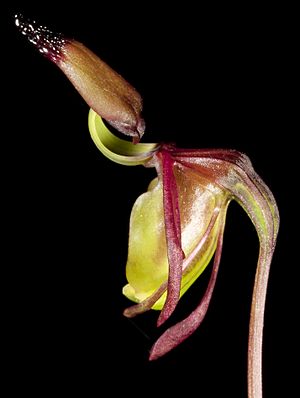Broad-billed duck orchid facts for kids
Quick facts for kids Broad-billed duck orchid |
|
|---|---|
 |
|
| Caleana triens in Wandoo National Park | |
| Scientific classification | |
| Genus: |
Caleana
|
| Species: |
triens
|
| Synonyms | |
|
Paracaleana triens Hopper & A.P.Br. |
|
The Broad-billed duck orchid (scientific name: Caleana triens) is a special type of orchid. It grows only in the south-west part of Western Australia. This means it is endemic to that area.
It has one smooth leaf. You can tell it apart by its flat labellum, which is like a lip. This lip has small bumps, called calli, only near its end. It also flowers quite early in the year.
What it Looks Like
The Broad-billed duck orchid has a single smooth leaf. This leaf can be dull green or dull red. It is about 15 to 30 millimeters (0.6 to 1.2 inches) long. It is also about 6 to 11 millimeters (0.2 to 0.4 inches) wide.
Usually, only one flower grows on each plant. The flower is greenish-yellow and red. It is about 20 to 25 millimeters (0.8 to 1.0 inches) long. It is also about 12 to 15 millimeters (0.5 to 0.6 inches) wide. This flower sits on a thin, wiry stalk. The stalk can be 60 to 140 millimeters (2.4 to 5.5 inches) tall.
The top part of the flower (dorsal sepal) and side parts (lateral sepals and petals) hang down. The top sepal presses against a part called the column. This forms a shape like a small bucket. The labellum, or lip, is flat. Only about one-third of its outer part has shiny black bumps or glands. These orchids usually bloom in September and October.
Naming the Orchid
The Broad-billed duck orchid was first officially described in 2006. Two scientists, Stephen Hopper and Andrew Brown, gave it the name Paracaleana triens. They found the first example, called the type specimen, near York. Their description was published in a science journal called Australian Systematic Botany.
Later, in 2014, other scientists studied the orchid's genes. Based on their findings, Joseph Miller and Mark Clements moved all Paracaleana species into the Caleana group. So, this orchid became Caleana triens.
The second part of its scientific name, triens, is a Latin word. It means "third." This refers to the fact that only one-third of the labellum's outer part has the small bumps (calli).
Where it Lives
The Broad-billed duck orchid grows in different types of natural areas. You can find it in forests, woodlands, or shrublands. It prefers sandy soil.
It grows in a region between York and Esperance. This area includes parts of the Avon Wheatbelt, Jarrah Forest, and Mallee regions.
Looking After It
The Western Australian Government's Department of Parks and Wildlife has looked at this orchid. They have classified Caleana triens (which they knew as Paracaleana triens) as "not threatened." This means it is not currently at risk of disappearing.

